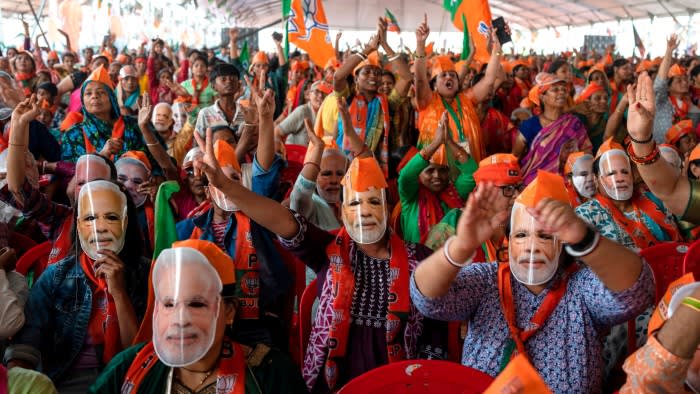Unlock the Editor’s Digest for free
Roula Khalaf, Editor of the FT, selects her favourite stories in this weekly newsletter.
The writer is chair of Rockefeller International
Having covered Indian elections since the 1990s, I have never seen a contest more predictable than the one beginning later this month. The only point still in debate is how big Prime Minister Narendra Modi’s re-election victory will be.
Modi’s critics say he has mobilised the machinery of the state to stack the election in his own favour, deploying investigators and other government agents to muzzle opponents. Yet there seems to be little public backlash over these methods, raising a larger question: how did such a vibrant democracy come to accept strongman rule?
I think what we are seeing is a kind of tacit deal, in which swing voters accept a democratic recession under Modi, so long as he delivers economic progress. While the hardcore supporters of his Bharatiya Janata party were always going to stand by their leader and the party’s Hindutva ideology, Modi has significantly expanded its traditional base by offering a deal that appeals to an increasing number of young and new voters.
This is reminiscent of east Asia after the second world war, when countries such as South Korea and Taiwan put together long runs of rapid growth with low inflation under autocratic leaders, who gave way to genuinely free elections only after their nations reached a middle-income level.
Under Modi, India has witnessed relatively robust economic growth, with low and stable inflation — much like the early east Asian model. It also has enjoyed a booming stock market, the rollout of gleaming infrastructure projects and new digital platforms that facilitate the delivery of welfare benefits.
Modi’s media machine drills home the point that, because of his initiatives, India’s stature is rising on the world stage. And I hear the same point repeated by Indians everywhere, from my travels to the badlands of Bihar to gatherings of rich expats in Manhattan.
It can be hard for outsiders to understand how much global status matters for emerging nations. As the old joke goes, three authors are asked to write on a topic of their choice: the Brit writes on how to rule the world, the American on how to make all the money in the world and the Indian on what the world thinks of India.
The argument can be made that India was rising before Modi, thanks to economic reforms undertaken by the Congress party in the early 1990s. The country had already climbed from the world’s 16th largest economy to the 10th by the time he took office in 2014. Yet those past achievements seem forgotten, and the previous Congress-led government is remembered largely for rampant corruption, economic fragility and weak leadership.
In a Pew poll this February, 67 per cent of Indian respondents expressed support for a “strong leader” who “can make decisions without interference from parliament or the courts”, up more than 10 percentage points since Modi’s early years in office. That was the essence of the east Asian bargain, and geopolitics makes it easier to accept.
Western capitals are looking to India as a counterweight to an assertive China, and so remain mostly quiet on the issue of civil and media liberties in New Delhi. In that silence, voters find no reason to question assertions that Modi is improving India’s image by creating a strong, nationalist state.
Many liberal Indians now speak of the country in ways that echo language I used to hear in east Asia. They say that in India there is still “freedom of speech but not freedom after speech”. Fearful of selective punishment, Indian businesses avoid saying anything remotely critical of the government, and 95 per cent of politicians investigated for corruption have been members of opposition parties.
Still, it’s too early to ring a death knell for Indian democracy. Critics credit Modi’s rise to the way he has centralised power in the prime minister’s office, to the organisational muscle of the BJP, and to its exploitation of hostility against Muslims and other minorities. But the unprecedented successes of the BJP are best explained by his personal appeal. The ruling party does not do as well in state elections where Modi’s name is not on the ballot. Nearly half the 28 states are ruled by opposition parties.
India’s democracy is in a recession — but it hasn’t gone bust. Voters have agreed to trade political freedom for perceived progress, but this deal is with Modi. It is likely to last only as long as he is in office and keeps delivering on the economic front.
